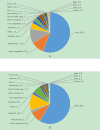Dietary cadmium exposure assessment among the Chinese population
- PMID: 28542445
- PMCID: PMC5436861
- DOI: 10.1371/journal.pone.0177978
Dietary cadmium exposure assessment among the Chinese population
Abstract
Cadmium, a toxic heavy metal, is widely present in food. It has been reported that chronic cadmium exposure is associated with kidney disease, osteoporosis, cardiovascular disease and cancer. The aim of this study was to assess the dietary cadmium exposure and potential health risk in different age-sex groups of the Chinese population (children aged 4-11 years, young people aged 12-17 years and adults aged over 18 years), and in the southern and northern population using a semi-probabilistic method. Cadmium was detected in 228,687 food samples from 32 food categrories by graphite furnace atomic absorption spectrometry. The dietary cadmium exposures were estimated by combining the cadmium concentration data with food consumption data derived from the China National Nutrient and Health Survey 2002, and evaluated against the Provisional Tolerable Monthly Intake (PTMI) of 25 μg/kg BW/month established by the Joint FAO/WHO expert committee on food additives (JECFA). The mean dietary cadmium exposure of the general Chinese population (15.3 μg/kg BW/month) was below the PTMI. The high consumer exposures (95th percentile, P95) for the general population and different sub-groups were higher than the PTMI. The dietary cadmium exposure of the southern population was apparently higher than that of the northern population. Rice was the most important contributor to cadmium exposure for Chinese people, especially those living in the southern areas of China. These findings indicated that the health risk from dietary cadmium exposure of the general Chinese people was low, but the health risk of cadmium exposure of certain sub-groups should be of concern.
Conflict of interest statement
Figures



References
-
- Vasileios AB, Eleonora N, Dimosthenis Nitas (2013) Arsenic, cadmium, lead and mercury as undesirable substances in animal feeds. Animal Science and Biotechnologies, 46:17–22
-
- EFSA (2009) Scientific opinion of the panel on contaminants in the food chain on a request from the European Commission on cadmium in food. The EFSA Journal, 980: 1–139.
-
- EC (1997) Opinion on cadmium expressed by the Scientific Committee for Food (SCF). Reports of the Scientific Committee for Food, 67–70. http://ec.europa.eu/food/fs/sc/scf/reports/scf_reports_36.pdf.
-
- FAO/WHO (2001) Evaluation of certain food additives and contaminants (Fifty-fifth report of the Joint FAO/WHO Expert Committee on Food Additives). WHO Technical Report Series, No. 901. http://whqlibdoc.who.int/trs/WHO_TRS_901.pdf.
-
- Kjellström T, Nordberg GF (1978) A kinetic model of cadmium metabolism in the human being. Environ Res, 16: 248–269. - PubMed
MeSH terms
Substances
LinkOut - more resources
Full Text Sources
Other Literature Sources
Medical
Research Materials
Miscellaneous

